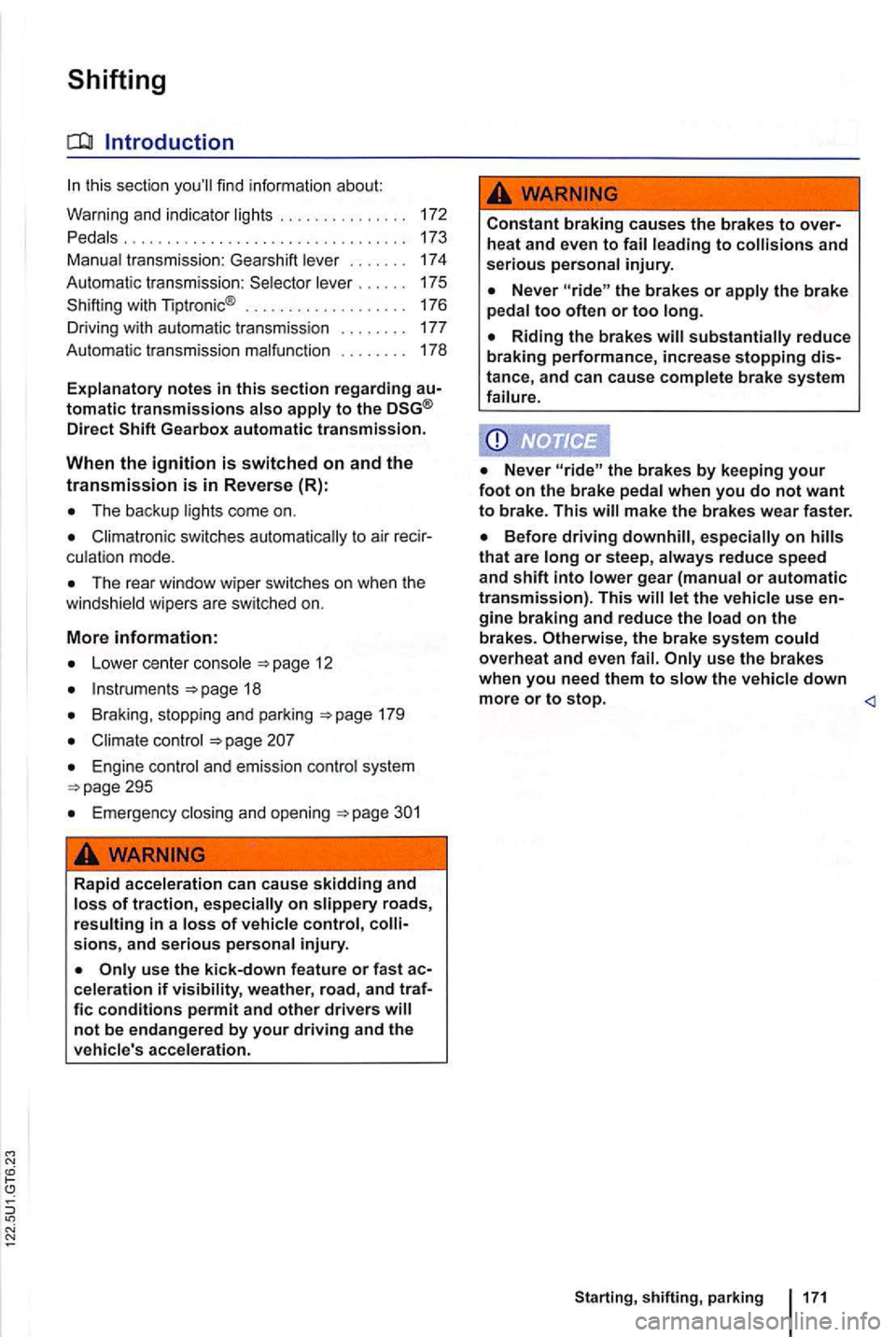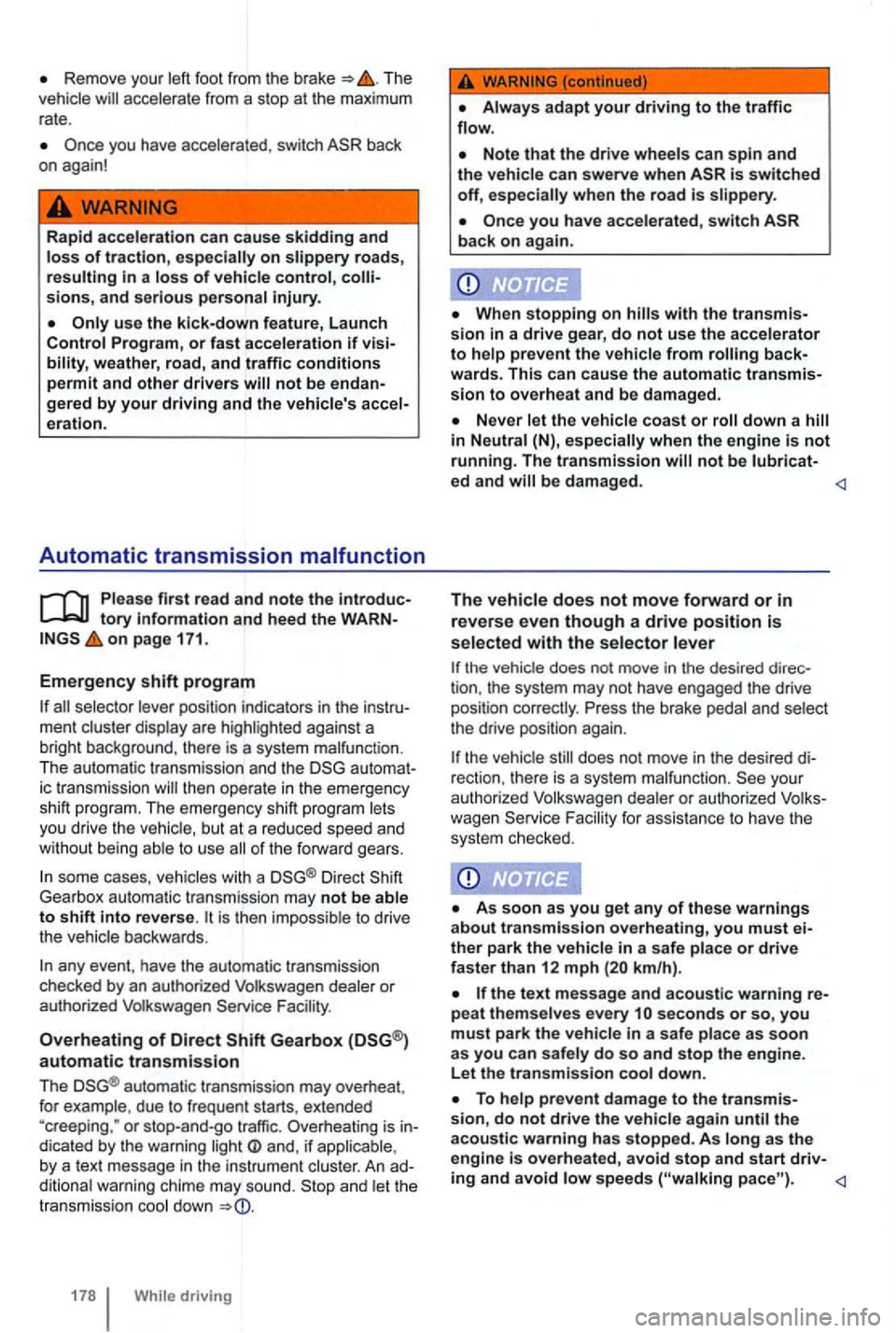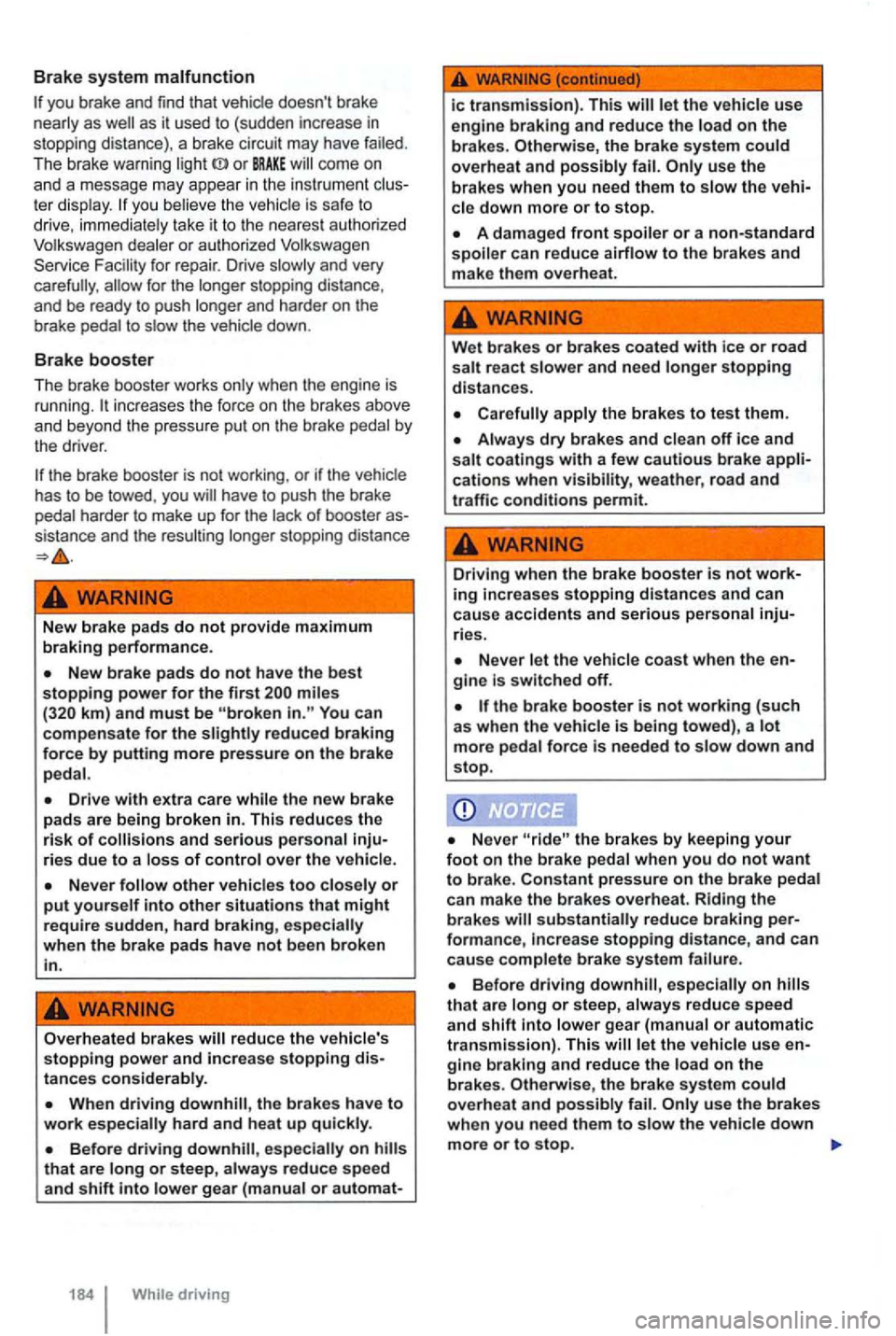Page 270 of 516

Shifting
Introduction
this section find information about:
Warning
and i ndicator ... .. . .
Pedals
............. ........... .
Manual transmission: Gearshift lever
172
173
174
Automat ic transm ission :
lever.... 175
Sh ifting with nptro nic ® . . . . . . . . . . . . . . . . . . 176
Driving with automatic transmiss ion 177
Automat ic transmission malfunction . . . . . . . . 178
Explanatory
notes in this sec tion regarding
Direct
The backup lights come on.
Climatronic switches to air culation mode.
The rear window wiper switches on when the
windshield wipers are switched on.
More information:
Braking , stoppi ng and parking 179
Climate control
Engine control and emission control system
Emergency
Rapid acceleration can cause skidding and loss of traction , especially on slippery roads,
re sulting in a loss of vehicle control, sions, and seriou s personal injury.
use the kick-down feature or fast cele ration if visibility, weather, road, and
Constant braking causes the brakes to and se rious personal injury.
the brakes or apply the brake
pedal too often or too long.
substantially reduce braking performance, increase stopping
the brakes by keeping your foot on the brake pedal when you do not want to brake . Thi s make the brakes wear faster.
gine braking and reduce the load on the brakes. Otherwise , the brake system could overheat and even
Page 277 of 516

Remove your left foot from the brake => The accelera te from a stop at the maximum
rate .
you have accelerated , swi tch
weather, road, and traffic conditions permit and other drivers not be gered by your driving and the vehicle's
tory on page 171.
Emergency shift program
selec to r ment
of the forward gears.
some cases, vehicles with a Direct
is then impossible to drive
the vehicle backwards .
any event , have the automatic transmission
checked by an authorized
Overheating of Direct automatic transmission
The automa tic transmission may overheat ,
for example , due to frequent starts , extended o r stop-and-go traffic. Overheating is and, if by a text message in the in strument ditional warning chime may sound. and let the
tr ansmission coo l down =>
178
is switched off, when the road is slippery.
you have accelerated, switch back on again.
with the
wards. This can cause the automatic sion to overheat and be damaged.
in Neutral (N), not be lubricat-ed and be damaged .
The vehicle does not move forward or in reverse even though a drive position is selected with the selector
the vehicle does not move in the desired tion , the system may not have engaged the drive
position Press the brake pedal and select the drive position again.
does not move in the desired rection , there is a system malfunctio n.
ther park the vehicle in a safe place or drive faster than 12 mph km/h) .
the tex t message and acoustic warning seconds or so, you must park the vehicle in a safe place as soon as you can safely do so and stop the engine .
L et the transmission cool down.
To help prevent damage to the sion, do not drive the vehicl e agai n until the
acoustic warning has s topped. As long as the
e ngine is overheated, avoid stop and start driv-ing and avoid low speed s pace") .
Page 283 of 516

Brake system malfunction
you brake and find that vehicle doesn't brake
nearly as
come on
and a m essage may appear in the instrument ter display. you believe the vehic le is safe to
d rive, immediately take it to the nearest authorized
Volkswagen dealer or authorized Volkswagen
Service
f or repair. Drive slowly and very
carefully , for the longer stopping distance ,
and be ready to push longer and harder on the
brake pedal to slow the vehicle down.
Brake booster
The brake booster works only when the engine is
running . in creases the force on the brakes above
and beyond the pressure put on the brake pedal by
the driver .
New brake pad s do not provide maximum braking performance.
miles You can
compensate for the reduc ed braking force by putting more pressure on the brake
pedal.
other vehicles too closel y or put yourself into other situations that might require sudden, hard braking , especially
when the brake pads have not b ee n broken
in.
Overh eated brakes reduce the vehicle's stopping power and increa se stopping distances considerably.
that are long or s teep, always reduce speed
and shift into lower gear (manual or automat-
184 While driving
ic transmission). This let the vehicle use
engine braking and reduce the load on the brakes. Otherwise, the brake system could overheat and possibly fail.
A damaged front spoiler or a non-standard spoiler can redu ce airflow to th e brakes and make them overheat.
Wet brakes or brakes coated with ice or road
salt react slower and need longer stopping distances.
apply the brakes to tes t them .
Driving when the brake booster is not working increases stopping distances and can
cause accidents and serious per sonal inju
rie s.
Nev er let the vehicle coas t when the
the bra ke booster is not working (suc h
a s wh en th e vehic le is being towed) , a lot more pedal force is needed to slow down and stop.
Neve r the brake s by keeping your foot on the brak e pedal when you do not want to brak e. Constant pres sure on the brake ped al
ca n make the brak es overheat. Riding the bra kes substantially r educe brakin g performance, increase stopping distance, and can
cause complete brake system failure .
that are long or s teep, always reduce speed and shift into lower gear (manua l or automatic tran smission). This gine brakin g and reduce the load on t he brakes. Otherwise, the brake system cou ld
o ve rheat and possibly fail. use the brakes when you n eed them to slow the vehicle down more or to stop.